
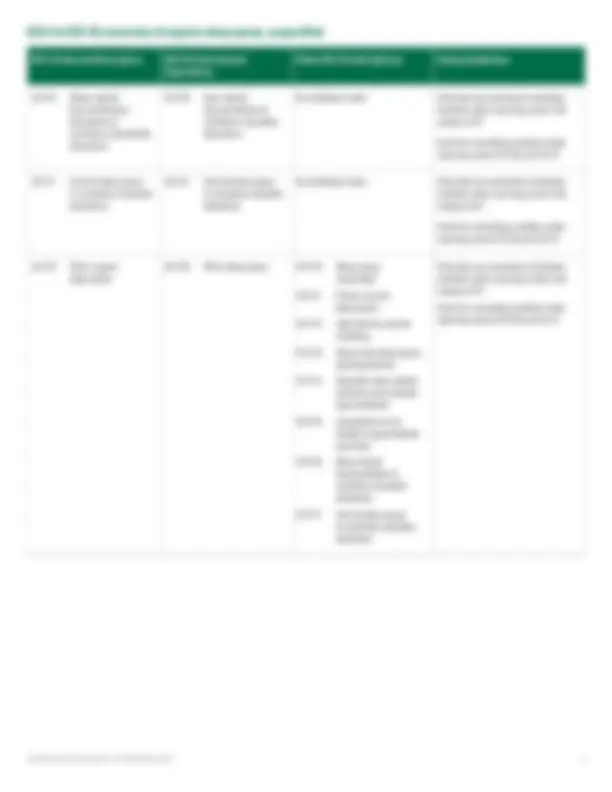


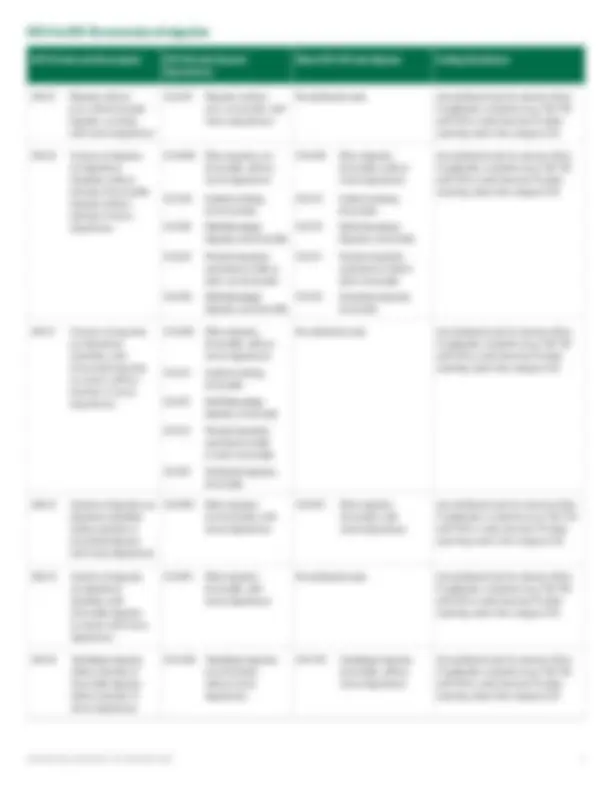
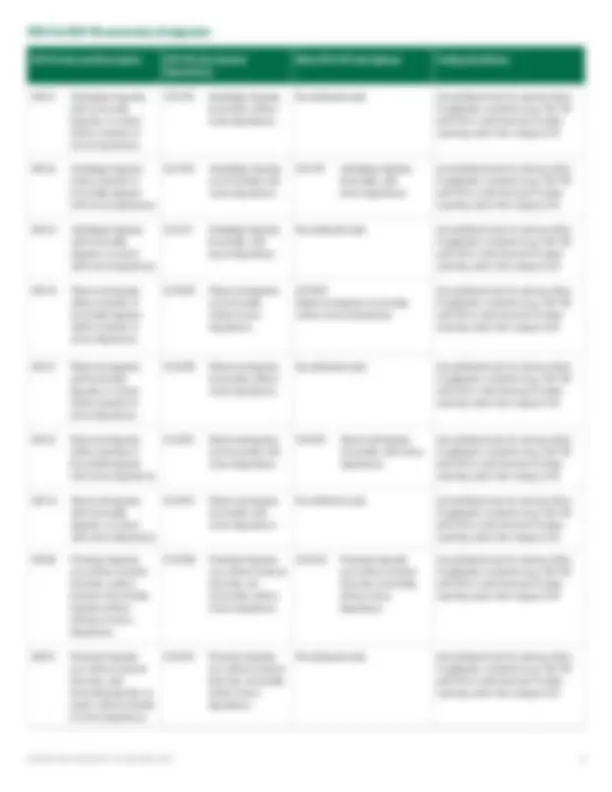
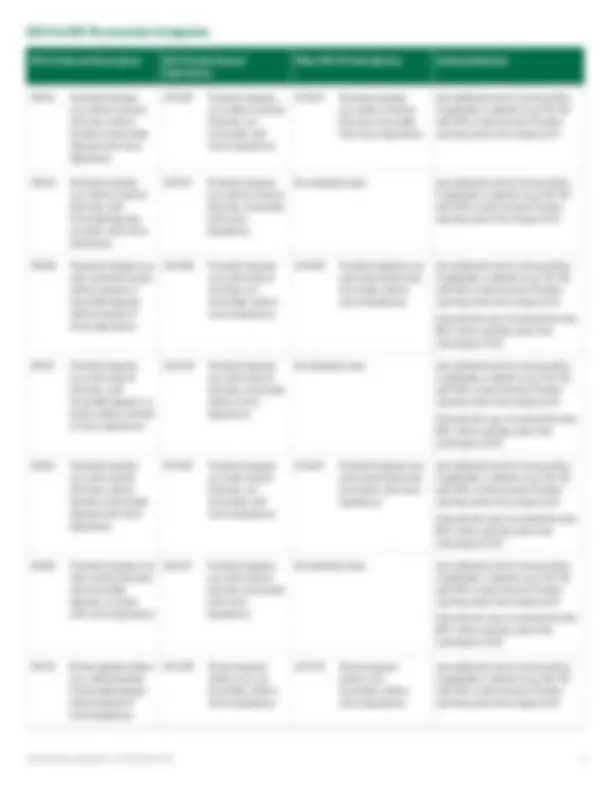



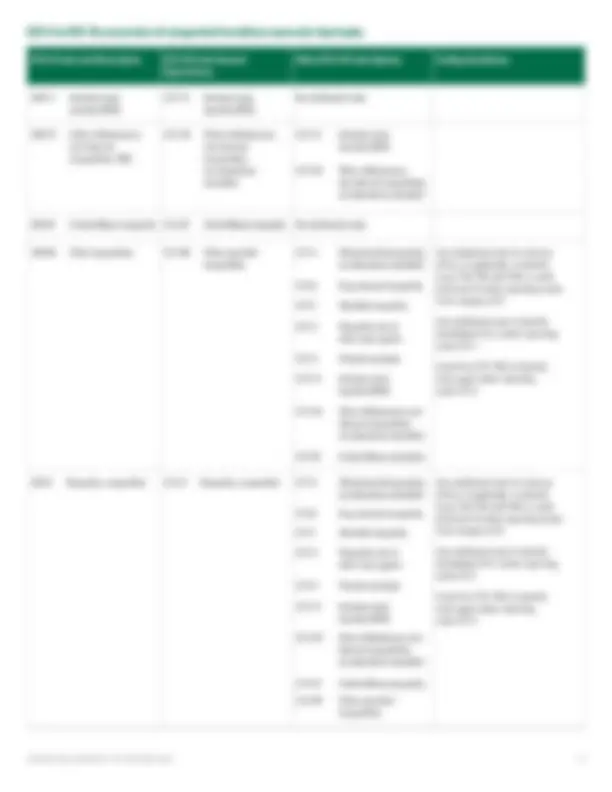






Study with the several resources on Docsity

Earn points by helping other students or get them with a premium plan


Prepare for your exams
Study with the several resources on Docsity

Earn points to download
Earn points by helping other students or get them with a premium plan
Community
Ask the community for help and clear up your study doubts
Discover the best universities in your country according to Docsity users
Free resources
Download our free guides on studying techniques, anxiety management strategies, and thesis advice from Docsity tutors
The ICD-9 to ICD-10 conversion codes for various types of migraines, including intractable and persistent migraines, hemiplegic migraines, menstrual migraines, and other forms of migraines. It also includes coding guidelines and instructions for reporting codes from subcategory G43.6 for cerebral infarction.
What you will learn
Typology: Study notes
1 / 22

This page cannot be seen from the preview
Don't miss anything!















ICD-9 Code and Description ICD-10 Code General Equivalency
Other ICD-10 Code Options Coding Guidelines
327.20 Organic sleep apnea, unspecified
G47.30 Sleep apnea, unspecified
G47.31 Primary central sleep apnea G47.32 High altitude periodic breathing G47.33 Obstructive sleep apnea (adult) (pediatric) G47.34 Idiopathic sleep related nonobstructive alveolar hypoventilation G47.35 Congenital central alveolar hypoventilation syndrome G47.36 Sleep related hypoventilation in conditions classified elsewhere G47.37 Central sleep apnea in conditions classified elsewhere G47.39 Other sleep apnea
Code also any associated underlying condition when reporting codes from category G
Code first underlying condition when reporting codes G47.36 and G47.
327.21 Primary central sleep apnea
G47.31 Primary central sleep apnea
No additional codes Code also any associated underlying condition when reporting codes from category G
327.22 High altitude periodic breathing
G47.32 High altitude periodic breathing
No additional codes Code also any associated underlying condition when reporting codes from category G
327.23 Obstructive sleep apnea (adult) (pediatric)
G47.33 Obstructive sleep apnea (adult) (pediatric)
No additional codes Code also any associated underlying condition when reporting codes from category G
327.24 Idiopathic sleep related non-obstructive alveolar hypoventilation
G47.34 Idiopathic sleep related nonobstructive alveolar hypoventilation
No additional codes Code also any associated underlying condition when reporting codes from category G
327.25 Congenital central alveolar hypoventilation syndrome
G47.35 Congenital central alveolar hypoventilation syndrome
No additional codes Code also any associated underlying condition when reporting codes from category G
ICD-9 Code and Description ICD-10 Code General Equivalency
Other ICD-10 Code Options Coding Guidelines
331.0 Alzheimer’s disease G30.9 Alzheimer’s disease, unspecified
G30.0 Alzheimer’s disease with early onset G30.1 Alzheimer’s disease with late onset G30.8 Other Alzheimer’s disease
Use additional code to identify: delirium, if applicable (F05) dementia with behavioral disturbance (F02.81) dementia without behavioral disturbance (F02.80) when reporting category G
ICD-9 Code and Description ICD-10 Code General Equivalency
Other ICD-10 Code Options Coding Guidelines
333.1 Essential and other specified forms of tremor
G25.0 Essential tremor G25.1 Drug-induced tremor G25.2 Other specified forms of tremor
No additional codes Use additional code for adverse effect, if applicable, to identify drug (T36-T with fifth or sixth character 5) when reporting code G25.
ICD-9 Code and Description ICD-10 Code General Equivalency
Other ICD-10 Code Options Coding Guidelines
346.00 Migraine with aura, without mention of intractable migraine without mention of status migrainosus
G43.109 Migraine with aura, not intractable, without status migrainosus
G43.119 Migraine with aura, intractable, without status migrainosus
Use additional code for adverse effect, if applicable, to identify drug (T36-T with fifth or sixth character 5) when reporting codes from category G
Code also any associated seizure (G40.-, R56.9) when reporting codes from subcategory G43.
346.01 Migraine with aura, with intractable migraine, so stated, without mention of status migrainosus
G43.119 Migraine with aura, intractable, without status migrainosus
No additional codes Use additional code for adverse effect, if applicable, to identify drug (T36-T with fifth or sixth character 5) when reporting codes from category G
Code also any associated seizure (G40.-, R56.9) when reporting codes from subcategory G43.
346.02 Migraine with aura, without mention of intractable migraine with status migrainosus
G43.101 Migraine with aura, not intractable, with status migrainosus
G43.111 Migraine with aura, intractable, with status migrainosus
Use additional code for adverse effect, if applicable, to identify drug (T36-T with fifth or sixth character 5) when reporting codes from category G
Code also any associated seizure (G40.-, R56.9) when reporting codes from subcategory G43.
346.03 Migraine with aura, with intractable migraine, so stated, with status migrainosus
G43.111 Migraine with aura, intractable, with status migrainosus
No additional codes Use additional code for adverse effect, if applicable, to identify drug (T36-T with fifth or sixth character 5) when reporting codes from category G
Code also any associated seizure (G40.-, R56.9) when reporting codes from subcategory G43.
346.10 Migraine without aura, without mention of intractable migraine without mention of status migrainosus
G43.009 Migraine without aura, not intractable, without status migrainosus
G43.019 Migraine without aura, intractable, without status migrainosus
Use additional code for adverse effect, if applicable, to identify drug (T36-T with fifth or sixth character 5) when reporting codes from category G
346.11 Migraine without aura, with intractable migraine, so stated, without mention of status migrainosus
G43.019 without aura, intractable, without status migrainosus
No additional codes Use additional code for adverse effect, if applicable, to identify drug (T36-T with fifth or sixth character 5) when reporting codes from category G
346.12 Migraine without aura, without mention of intractable migraine with status migrainosus
G43.001 Migraine without aura, not intractable, with status migrainosus
G43.011 Migraine without aura, intractable, with status migrainosus
Use additional code for adverse effect, if applicable, to identify drug (T36-T with fifth or sixth character 5) when reporting codes from category G
ICD-9 Code and Description ICD-10 Code General Equivalency
Other ICD-10 Code Options Coding Guidelines
346.13 Migraine without aura, with intractable migraine, so stated, with status migrainosus
G43.011 Migraine without aura, intractable, with status migrainosus
No additional codes Use additional code for adverse effect, if applicable, to identify drug (T36-T with fifth or sixth character 5) when reporting codes from category G
346.20 Variants of migraine, not elsewhere classified, without mention of intractable migraine without mention of status migrainosus
G43.809 Other migraine, not intractable, without status migrainosus
G43.819 Other migraine, intractable, without status migrainosus
Use additional code for adverse effect, if applicable, to identify drug (T36-T with fifth or sixth character 5) when reporting codes from category G G43.A0 Cyclical vomiting, not intractable
G43.A1 Cyclical vomiting, intractable G43.B0 Ophthalmoplegic migraine, not intractable
G43.B1 Ophthalmoplegic migraine, intractable G43.C0 Periodic headache syndromes in child or adult, not intractable
G43.C1 Periodic headache syndromes in child or adult, intractable G43.D0 Ophthalmoplegic migraine, not intractable
G43.D1 Abdominal migraine, intractable
346.21 Variants of migraine, not elsewhere classified, with intractable migraine, so stated, without mention of status migrainosus
G43.819 Other migraine, intractable, without status migrainosus
No additional codes Use additional code for adverse effect, if applicable, to identify drug (T36-T with fifth or sixth character 5) when G43.A1 Cyclical vomiting, reporting codes from category G intractable G43.B1 Ophthalmoplegic migraine, intractable G43.C1 Periodic headache syndromes in child or adult, intractable G43.D1 Abdominal migraine, intractable
346.22 Variants of migraine, not elsewhere classified, without mention of intractable migraine with status migrainosus
G43.801 Other migraine, not intractable, with status migrainosus
G43.811 Other migraine, intractable, with status migrainosus
Use additional code for adverse effect, if applicable, to identify drug (T36-T with fifth or sixth character 5) when reporting codes from category G
346.23 Variants of migraine, not elsewhere classified, with intractable migraine, so stated, with status migrainosus
G43.811 Other migraine, intractable, with status migrainosus
No additional codes Use additional code for adverse effect, if applicable, to identify drug (T36-T with fifth or sixth character 5) when reporting codes from category G
346.30 Hemiplegic migraine, without mention of intractable migraine without mention of status migrainosus
G43.409 Hemiplegic migraine, not intractable, without status migrainosus
G43.419 Hemiplegic migraine, intractable, without status migrainosus
Use additional code for adverse effect, if applicable, to identify drug (T36-T with fifth or sixth character 5) when reporting codes from category G
ICD-9 Code and Description ICD-10 Code General Equivalency
Other ICD-10 Code Options Coding Guidelines
346.52 Persistent migraine aura without cerebral infarction, without mention of intractable migraine with status migrainosus
G43.501 Persistent migraine aura without cerebral infarction, not intractable, with status migrainosus
G43.511 Persistent migraine aura without cerebral infarction, intractable, with status migrainosus
Use additional code for adverse effect, if applicable, to identify drug (T36-T with fifth or sixth character 5) when reporting codes from category G
346.53 Persistent migraine aura without cerebral infarction, with intractable migraine, so stated, with status migrainosus
G43.511 Persistent migraine aura without cerebral infarction, intractable, with status migrainosus
No additional codes Use additional code for adverse effect, if applicable, to identify drug (T36-T with fifth or sixth character 5) when reporting codes from category G
346.60 Persistent migraine aura with cerebral infarction, without mention of intractable migraine without mention of status migrainosus
G43.609 Persistent migraine aura with cerebral infarction, not intractable, without status migrainosus
G43.619 Persistent migraine aura with cerebral infarction, intractable, without status migrainosus
Use additional code for adverse effect, if applicable, to identify drug (T36-T with fifth or sixth character 5) when reporting codes from category G Code also the type of cerebral infarction (I63.-) when reporting codes from subcategory G43.
346.61 Persistent migraine aura with cerebral infarction, with intractable migraine, so stated, without mention of status migrainosus
G43.619 Persistent migraine aura with cerebral infarction, intractable, without status migrainosus
No additional codes Use additional code for adverse effect, if applicable, to identify drug (T36-T with fifth or sixth character 5) when reporting codes from category G Code also the type of cerebral infarction (I63.-) when reporting codes from subcategory G43.
346.62 Persistent migraine aura with cerebral infarction, without mention of intractable migraine with status migrainosus
G43.601 Persistent migraine aura with cerebral infarction, not intractable, with status migrainosus
G43.611 Persistent migraine aura with cerebral infarction, intractable, with status migrainosus
Use additional code for adverse effect, if applicable, to identify drug (T36-T with fifth or sixth character 5) when reporting codes from category G Code also the type of cerebral infarction (I63.-) when reporting codes from subcategory G43.
346.63 Persistent migraine aura with cerebral infarction, with intractable migraine, so stated, with status migrainosus
G43.611 Persistent migraine aura with cerebral infarction, intractable, with status migrainosus
No additional codes Use additional code for adverse effect, if applicable, to identify drug (T36-T with fifth or sixth character 5) when reporting codes from category G Code also the type of cerebral infarction (I63.-) when reporting codes from subcategory G43.
346.70 Chronic migraine without aura, without mention of intractable migraine without mention of status migrainosus
G43.709 Chronic migraine without aura, not intractable, without status migrainosus
G43.719 Chronic migraine without aura, intractable, without status migrainosus
Use additional code for adverse effect, if applicable, to identify drug (T36-T with fifth or sixth character 5) when reporting codes from category G
ICD-9 Code and Description ICD-10 Code General Equivalency
Other ICD-10 Code Options Coding Guidelines
346.71 Chronic migraine without aura, with intractable migraine, so stated, without mention of status migrainosus
G43.719 Chronic migraine without aura, intractable, without status migrainosus
No additional codes Use additional code for adverse effect, if applicable, to identify drug (T36-T with fifth or sixth character 5) when reporting codes from category G
346.72 Chronic migraine without aura, without mention of intractable migraine with status migrainosus
G43.701 Chronic migraine without aura, not intractable, with status migrainosus
G43.711 Chronic migraine without aura, intractable, with status migrainosus
Use additional code for adverse effect, if applicable, to identify drug (T36-T with fifth or sixth character 5) when reporting codes from category G
346.73 Chronic migraine without aura, with intractable migraine, so stated, with status migrainosus
G43.711 Chronic migraine without aura, intractable, with status migrainosus
No additional codes Use additional code for adverse effect, if applicable, to identify drug (T36-T with fifth or sixth character 5) when reporting codes from category G
346.80 Other forms of migraine, without mention of intractable migraine without mention of status migrainosus
G43.809 Other migraine, not intractable, without status migrainosus
G43.819 Other migraine, intractable, without status migrainosus
Use additional code for adverse effect, if applicable, to identify drug (T36-T with fifth or sixth character 5) when reporting codes from category G
346.81 Other forms of migraine, with intractable migraine, so stated, without mention of status migrainosus
G43.819 Other migraine, intractable, without status migrainosus
No additional codes Use additional code for adverse effect, if applicable, to identify drug (T36-T with fifth or sixth character 5) when reporting codes from category G
346.82 Other forms of migraine, without mention of intractable migraine with status migrainosus
G43.801 Other migraine, not intractable, with status migrainosus
G43.811 Other migraine, intractable, with status migrainosus
Use additional code for adverse effect, if applicable, to identify drug (T36-T with fifth or sixth character 5) when reporting codes from category G
346.83 Other forms of migraine, with intractable migraine, so stated, with status migrainosus
G43.811 Other migraine, intractable, with status migrainosus
No additional codes Use additional code for adverse effect, if applicable, to identify drug (T36-T with fifth or sixth character 5) when reporting codes from category G
ICD-9 Code and Description ICD-10 Code General Equivalency
Other ICD-10 Code Options Coding Guidelines
346.91 Migraine, unspecified, with intractable migraine, so stated, without mention of status migrainosus
G43.919 Migraine, unspecified, intractable, without status migrainosus
G43.019 Migraine without aura, intractable, without status migrainosus
Use additional code for adverse effect, if applicable, to identify drug (T36-T with fifth or sixth character 5) when reporting codes from category G
Code also any associated seizure (G40.-, R56.9) when reporting codes from subcategory G43.
Code also the type of cerebral infarction (I63.-) when reporting codes from subcategory G43.
G43.119 Migraine with aura, intractable, without status migrainosus
G43.419 Hemiplegic migraine, intractable, without status migrainosus
G43.519 Persistent migraine aura without cerebral infarction, intractable, without status migrainosus
G43.619 Persistent migraine aura with cerebral infarction, intractable, without status migrainosus
G43.719 Chronic migraine without aura, intractable, without status migrainosus
G43.B1 Ophthalmoplegic migraine, intractable
G43.D1 Abdominal migraine, intractable
G43.819 Other migraine, intractable, without status migrainosus
G43.839 Menstrual migraine, intractable, without status migrainosus
ICD-9 Code and Description ICD-10 Code General Equivalency
Other ICD-10 Code Options Coding Guidelines
346.92 Migraine, unspecified, without mention of intractable migraine with status migrainosus
G43.901 Migraine, unspecified, not intractable, with status migrainosus
G43.001 Migraine without aura, not intractable, with status migrainosus
Use additional code for adverse effect, if applicable, to identify drug (T36-T with fifth or sixth character 5) when reporting codes from category G
Code also any associated seizure (G40.-, R56.9) when reporting codes from subcategory G43.
Code also the type of cerebral infarction (I63.-) when reporting codes from subcategory G43.
G43.101 Migraine with aura, not intractable, with status migrainosus
G43.401 Hemiplegic migraine, not intractable, with status migrainosus
G43.501 Persistent migraine aura without cerebral infarction, not intractable, with status migrainosus
G43.601 Persistent migraine aura with cerebral infarction, not intractable, with status migrainosus
G43.701 Chronic migraine without aura, not intractable, with status migrainosus
G43.B0 Ophthalmoplegic migraine, not intractable
G43.D0 Abdominal migraine, not intractable
G43.801 Other migraine, not intractable, with status migrainosus
G43.821 Menstrual migraine, not intractable, with status migrainosus
ICD-9 Code and Description ICD-10 Code General Equivalency
Other ICD-10 Code Options Coding Guidelines
356.0 Hereditary peripheral neuropathy
G60.0 Hereditary motor and sensory neuropathy
No additional codes
356.1 Peroneal muscular atrophy
G60.0 Hereditary motor and sensory neuropathy
No additional codes
356.2 Hereditary sensory neuropathy
G60.0 Hereditary motor and sensory neuropathy
No additional codes
356.3 Refsum’s disease G60.1 Refsum’s disease No additional codes
356.4 Idiopathic progressive polyneuropathy
G60.3 Idiopathic progressive neuropathy
No additional codes
356.8 Other specified idiopathic peripheral neuropathy
G60.8 Other hereditary and idiopathic neuropathies
G60.0 Hereditary motor and sensory neuropathy G60.1 Refsum’s diseasew G60.2 Neuropathy in association with hereditary ataxia G60.3 Idiopathic progressive neuropathy
356.9 Unspecified hereditary and idiopathic peripheral neuropathy
G60.9 Hereditary and idiopathic neuropathy, unspecified
G60.0 Hereditary motor and sensory neuropathy G60.1 Refsum’s disease G60.2 Neuropathy in association with hereditary ataxia G60.3 Idiopathic progressive neuropathy G60.8 Other hereditary and idiopathic neuropathies
ICD-9 Code and Description ICD-10 Code General Equivalency
Other ICD-10 Code Options Coding Guidelines
359.0 Congenital hereditary muscular dystrophy
G71.2 Congenital myopathies No additional codes
359.1 Hereditary progressive muscular dystrophy
G71.0 Muscular dystrophy No additional codes
359.21 Myotonic muscular dystrophy
G71.11 Myotonic muscular dystrophy
No additional codes
359.22 Myotonia congenita G71.12 Myotonia congenita No additional codes
359.23 Myotonic chondrodystrophy
G71.13 Myotonic chondrodystrophy
No additional codes
359.24 Drug-induced myotonia
G71.14 Drug-induced myotonia
No additional codes Use additional code for adverse effect, if applicable, to identify drug (T36-T with fifth or sixth character 5) when reporting code G71.
359.29 Other specified myotonic disorder
G71.19 Other specified myotonic disorders
G71.11 Myotonic muscular dystrophy
Use additional code for adverse effect, if applicable, to identify drug (T36-T with fifth or sixth character 5) when reporting code G71.
G71.12 Myotonia congenita G71.13 Myotonic chondrodystrophy G71.14 Drug induced myotonia G71.2 Congenital myopathies G71.3 Mitochondrial myopathy, not elsewhere classified G71.8 Other primary disorders of muscles
359.3 Periodic paralysis G72.3 Periodic paralysis No additional codes
359.4 Toxic myopathy G72.2 Myopathy due to other toxic agents
No additional codes Code first (T51-T65) to identify toxic agent when reporting code G72.
359.5 Myopathy in endocrine diseases classified elsewhere
G73.7 Myopathy in diseases classified elsewhere
No additional codes Code first underlying disease, such as: hyperparathyroidism (E21.0, E21.3) hypoparathyroidism (E20.-) glycogen storage disease (E74.0) lipid storage disorders (E75.-) when reporting code G73.
359.6 Symptomatic inflammatory myopathy in diseases classified elsewhere
G73.7 Myopathy in diseases classified elsewhere
No additional codes Code first underlying disease, such as: hyperparathyroidism (E21.0, E21.3) hypoparathyroidism (E20.-) glycogen storage disease (E74.0) lipid storage disorders (E75.-) when reporting code G73.
ICD-9 Code and Description ICD-10 Code General Equivalency
Other ICD-10 Code Options Coding Guidelines
386.11 Benign paroxysmal positional vertigo
H81.13 Benign paroxysmal vertigo, bilateral
H81.11 Benign paroxysmal vertigo, right ear H81.12 Benign paroxysmal vertigo, left ear
ICD-9 Code and Description ICD-10 Code General Equivalency
Other ICD-10 Code Options Coding Guidelines
780.2 Syncope and collapse R55 Syncope and collapse G90.01 Carotid sinus syncope
T67.1XXA Heat syncope, initial encounter
T67.1XXD Heat syncope, subsequent encounter
T67.1XXS Heat syncope, sequela